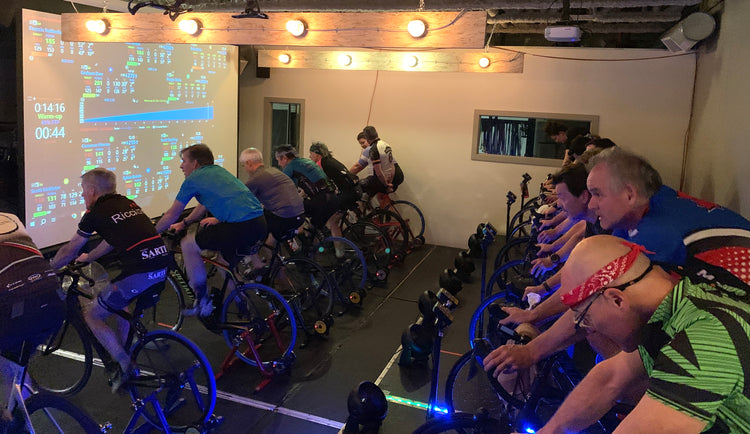2006 – Our Start
Chasing FTP. Chasing Threshold. Chasing Glory. Chasing Burnout.
The fitness industry has exploded since our inauguration in 2006. The invention of power meters has changed the game in cycling, most of it good! We finally have a metric to gauge our effort precisely. No more old school of “going by feel.” We can use more than heart rate which wasn’t great for intervals and short efforts. Mathematicians took all our data from workouts and starting plotting everything. Peak power scores, averages, steady-states and recoveries. Training with power revolutionized coaching and training.
“Nothing comes close to having a greater impact on the length and quality of your life than your training. And unfortunately, we can’t put it in a pill. You’ve got to be able to do it. There’s no biohack for it.” —Peter Attia
Indoor Explosion
Think back to the program you used to train with inside 10 years ago which would be similar to our old mobile phones. They enabled us to call and text but not much more. Graphics were limited and you couldn’t tap! Today, we have clients who prefer to ride inside more than outdoor as the online programs are entertaining, competitive and safe. I remember riding in a basement on rollers looking at the wall and trying to tell myself this is “good to do.” There was no fun component to a lot of our training back then and none of us were going pro! For stimulation, we relied on group exercise and classes. Meeting in someone’s garage was the entertainment and motivation. The Garage Gang was born.
FTP (Functional Threshold Power)
The number which is the holy grail of cycling. What’s your FTP? Every class or program you enter today still asks or tries to measure your FTP as a key measure of progress. Indoor cycling is still based off this number. When Lance Armstrong’s FTP was reportedly around 400 watts, we knew what greatness was. It was essentially double that of an average cyclist. Local racers would aim for 300 watts which was like running 10km race under 40 min or running a sub 3:00 marathon. Lance brought the use of power to a new level. Today, many cyclists aim to increase their FTP as a primary objective of improving their fitness.
The Ceiling
In over 25 years of providing FTP builder programs and classes, I have seen the FTP number become a great motivator and symbol of one’s cycling ability. A status symbol. My FTP is XXX. However, we all have a genetic limit and need to understand that your FTP does not go up every year. After the initial bump and increase in your power which is primarily due to neuromuscular coordination and improved technique, we hit a soft ceiling. We can boost it up 10-20 watts with structured training which makes us feel good and strong. This increase is short-lived as our body does return to its set point. We cannot train like maniacs every month without taking time to rest and unwind. That’s OK, we are not automobiles. Take the highs with the lows.
The Hour of Power
The ultimate test of your ability to ride with great intensity. The number you can average for one hour is known as your FTP, the old school way. Scientists and coaches have modified that one-hour test into a 20 min effort and even shorter. We use math to predicts what your “hour of power” should theoretically be. Over the years, we found that this test and chasing a bigger FTP each year was detrimental to your enjoyment of cycling and to some extent mental health. People would not show up for class on FTP night! So, we stopped using this assessment a few years ago. We could calculate it other ways through software and scanning all your previous workouts.
The Hour of Power comeback
I thought you said, “we don’t test” FTP anymore? That is correct. However, we ran into an issue with indoor classes and coaching clients. No one wanted to decrease their number in the off-season to what it should be! Primarily men! Some clients would say, “drop it 10 watts as I haven’t been riding much this fall.” What we discovered is that most people needed to decrease it significantly more, 20-50 watts!
This year we programmed a “hour of power” class with over 100 cyclists. The first time since 2014. The results were very interesting. 5% of the clients improved their number. The majority did not. However, they all completed the hour effort with everything they had. They paced themselves and pedalled hard when they could. They had some lows in that hour but also rebounded and got back on track. Completion rate: 100%. They did one hour. Everyone was happy on their accomplishment. “I just road a hour at my best effort. My FTP decreased but that’s OK. I truly know what I can do. Let’s use that number going forward.”
Lessons from Colombia, Italy and Spain
We have been fortunate to run training camps in foreign countries not only known for their warm weather and culture, but also great cyclists. We have hired local guides to guide us through the winding terrains and big rides. The guides are gifted riders, some of whom used to race. What did they use for metrics on their bikes? Not much. Distance and time were the key variables. Power? Not often. FTP? They did not talk of this metric much nor ride by it as a tool. But they were so good! What’s their secret? They ride a lot. They ride aerobically and they smile a lot. They have skill which goes a long way in performance.
What about Canada? We have to go inside because it’s freezing 6 months of the year! That’s what I would tell these guides who live in warm climates. We need to keep motivated and power training helps that process. However, we must remember that riding skills and enjoying the process is equally important. The biggest engine or the lightest bike does not win the race. Our goal is to have our clients work on their skills as much as their time improving their FTP.
The Long Play
As we age, our FTP will naturally start to decrease, but that’s OK. We have members in our classes that are well into their 70’s and still hold 90% of what they did in their 50’s. Our aging clients are smart. They move every day, not just when they have time. They are not weekend warriors but rather weekly warriors! They stay consistent with their exercise as decreasing your movement as you age gets harder to rebuild. Keep your engine revving. My advice is to look at your exercise plan on a 12-month schedule. Can you do your routine every week of the year? That’s the goal, consistency of movement. Your body will love you for it. Your FTP will also be close by.









